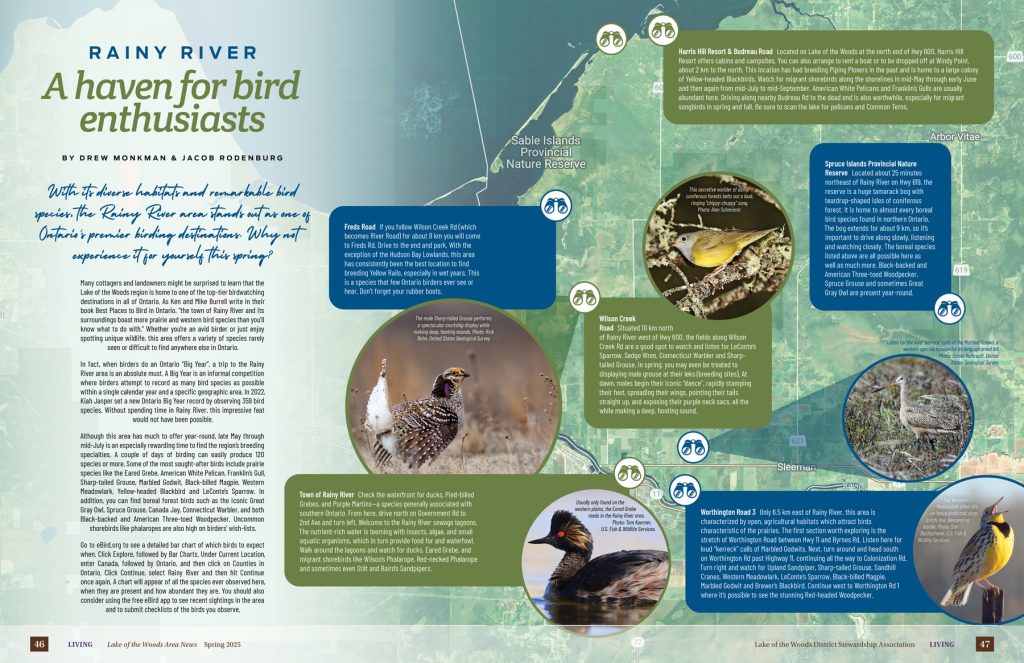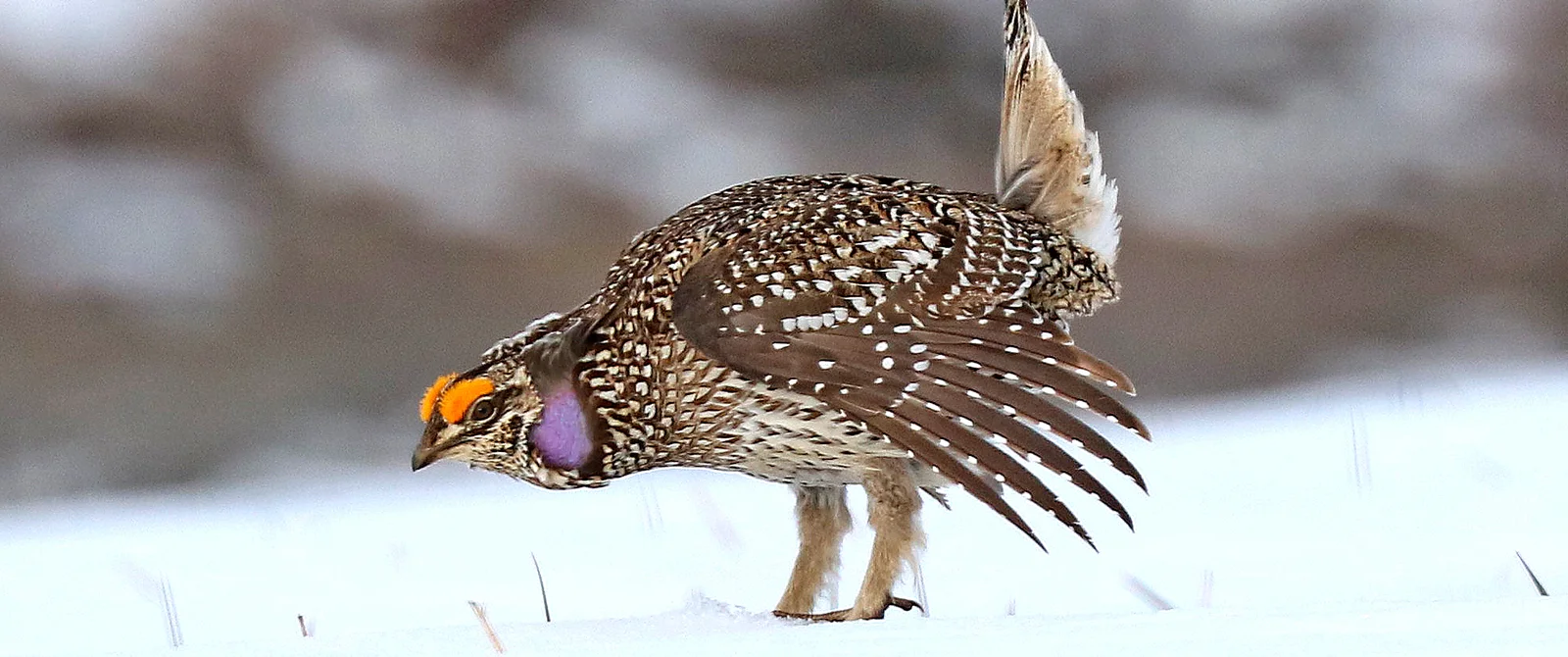Originally published in Lake of the Woods Area News, Volume 55, Number 2, Spring 2025
With its diverse habitats and remarkable bird species, the Rainy River area stands out as one of Ontario’s premier birding destinations. Why not experience it for yourself this spring?
Many cottagers and landowners might be surprised to learn that the Lake of the Woods region is home to one of the top-tier birdwatching destinations in all of Ontario. As Ken and Mike Burrell write in their book Best Places to Bird in Ontario, “the town of Rainy River and its surroundings boast more prairie and western bird species than you’ll know what to do with.” Whether you’re an avid birder or just enjoy spotting unique wildlife, this area offers a variety of species rarely seen or difficult to find anywhere else in Ontario.
In fact, when birders do an Ontario “Big Year”, a trip to the Rainy River area is an absolute must. A Big Year is an informal competition where birders attempt to record as many bird species as possible within a single calendar year and a specific geographic area. In 2022, Kiah Jasper set a new Ontario Big Year record by observing 359 bird species. Without spending time in Rainy River, this impressive feat would not have been possible.
Although this area has much to offer year-round, late May through mid-July is an especially rewarding time to find the region’s breeding specialties. A couple of days of birding can easily produce 120 species or more. Some of the most sought-after birds include prairie species like the Eared Grebe, American White Pelican, Franklin’s Gull, Sharp-tailed Grouse, Marbled Godwit, Black-billed Magpie, Western Meadowlark, Yellow-headed Blackbird and LeConte’s Sparrow. In addition, you can find boreal forest birds such as the iconic Great Gray Owl, Spruce Grouse, Canada Jay, Connecticut Warbler, and both Black-backed and American Three-toed Woodpecker. Uncommon shorebirds like phalaropes are also high on birders’ wish-lists.
Go to eBird.org to see a detailed bar chart of which birds to expect when. Click Explore, followed by Bar Charts. Under Current Location, enter Canada, followed by Ontario, and then click on Counties in Ontario. Click Continue, select Rainy River and then hit Continue once again. A chart will appear of all the species ever observed here, when they are present and how abundant they are. You should also consider using the free eBird app to see recent sightings in the area and to submit checklists of the birds you observe.
Spruce Islands Provincial Nature Reserve ocated about 25 minutes northeast of Rainy River on Hwy 619, the reserve is a huge tamarack bog with teardrop-shaped isles of coniferous forest. It is home to almost every boreal bird species found in northern Ontario. The bog extends for about 9 km, so it’s important to drive along slowly, listening and watching closely. The boreal species listed above are all possible here as well as much more. Black-backed and American Three-toed Woodpecker, Spruce Grouse and sometimes Great Gray Owl are present year-round.
Worthington Road 3 Only 6.5 km east of Rainy River, this area is characterized by open, agricultural habitats which attract birds characteristic of the prairies. The first section worth exploring is the stretch of Worthington Road between Hwy 11 and Byrnes Rd. Listen here for loud “kerreck” calls of Marbled Godwits. Next, turn around and head south on Worthington Rd past Highway 11, continuing all the way to Colonization Rd. Turn right and watch for Upland Sandpiper, Sharp-tailed Grouse, Sandhill Cranes, Western Meadowlark, LeConte’s Sparrow, Black-billed Magpie, Marbled Godwit and Brewer’s Blackbird. Continue west to Worthington Rd 1 where it’s possible to see the stunning Red-headed Woodpecker.
Town of Rainy River Check the waterfront for ducks, Pied-billed Grebes, and Purple Martins—a species generally associated with southern Ontario. From here, drive north on Government Rd to 2nd Ave and turn left. Welcome to the Rainy River sewage lagoons. The nutrient-rich water is teeming with insects, algae, and small aquatic organisms, which in turn provide food for and waterfowl. Walk around the lagoons and watch for ducks, Eared Grebe, and migrant shorebirds like Wilson’s Phalarope, Red-necked Phalarope and sometimes even Stilt and Baird’s Sandpipers.
Wilson Creek Road ituated 10 km north of Rainy River west of Hwy 600, the fields along Wilson Creek Rd are a good spot to watch and listen for LeConte’s Sparrow, Sedge Wren, Connecticut Warbler and Sharp-tailed Grouse. In spring, you may even be treated to displaying male grouse at their leks (breeding sites). At dawn, males begin their iconic “dance”, rapidly stamping their feet, spreading their wings, pointing their tails straight up, and exposing their purple neck sacs, all the while making a deep, hooting sound.
Freds Road If you follow Wilson Creek Rd (which becomes River Road) for about 8 km you will come to Freds Rd. Drive to the end and park. With the exception of the Hudson Bay Lowlands, this area has consistently been the best location to find breeding Yellow Rails, especially in wet years. This is a species that few Ontario birders ever see or hear. Don’t forget your rubber boots.
Harris Hill Resort & Budreau Road Located on Lake of the Woods at the north end of Hwy 600, Harris Hill Resort offers cabins and campsites. You can also arrange to rent a boat or to be dropped off at Windy Point, about 2 km to the north. This location has had breeding Piping Plovers in the past and is home to a large colony of Yellow-headed Blackbirds. Watch for migrant shorebirds along the shorelines in mid-May through early June and then again from mid-July to mid-September. American White Pelicans and Franklin’s Gulls are usually abundant here. Driving along nearby Budreau Rd to the dead end is also worthwhile, especially for migrant songbirds in spring and fall. Be sure to scan the lake for pelicans and Common Terns.

